CHEVROLET CAMARO SS 2010 Owners Manual
Manufacturer: CHEVROLET, Model Year: 2010, Model line: CAMARO SS, Model: CHEVROLET CAMARO SS 2010Pages: 372, PDF Size: 1.91 MB
Page 271 of 372
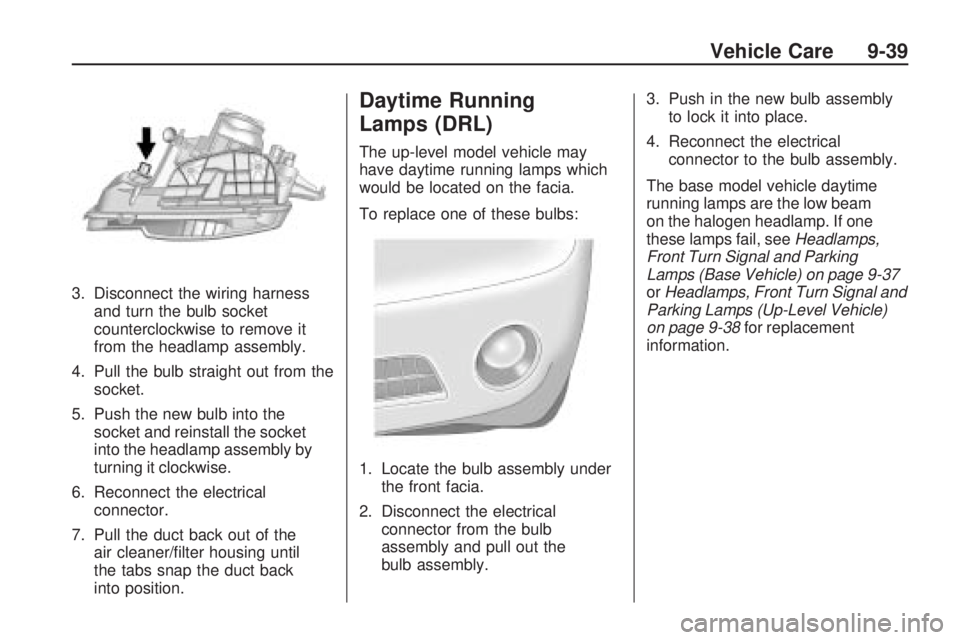
3. Disconnect the wiring harness
and turn the bulb socket
counterclockwise to remove it
from the headlamp assembly.
4. Pull the bulb straight out from the
socket.
5. Push the new bulb into the
socket and reinstall the socket
into the headlamp assembly by
turning it clockwise.
6. Reconnect the electrical
connector.
7. Pull the duct back out of the
air cleaner/filter housing until
the tabs snap the duct back
into position.
Daytime Running
Lamps (DRL)
The up-level model vehicle may
have daytime running lamps which
would be located on the facia.
To replace one of these bulbs:
1. Locate the bulb assembly under
the front facia.
2. Disconnect the electrical
connector from the bulb
assembly and pull out the
bulb assembly.3. Push in the new bulb assembly
to lock it into place.
4. Reconnect the electrical
connector to the bulb assembly.
The base model vehicle daytime
running lamps are the low beam
on the halogen headlamp. If one
these lamps fail, seeHeadlamps,
Front Turn Signal and Parking
Lamps (Base Vehicle) on page 9-37
orHeadlamps, Front Turn Signal and
Parking Lamps (Up-Level Vehicle)
on page 9-38for replacement
information.
Vehicle Care 9-39
Page 272 of 372
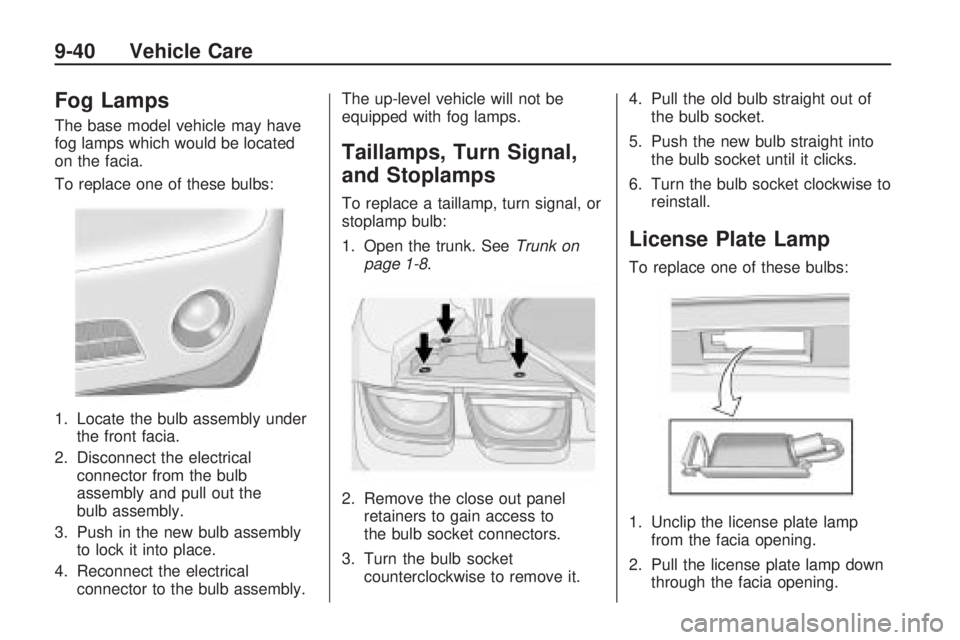
Fog Lamps
The base model vehicle may have
fog lamps which would be located
on the facia.
To replace one of these bulbs:
1. Locate the bulb assembly under
the front facia.
2. Disconnect the electrical
connector from the bulb
assembly and pull out the
bulb assembly.
3. Push in the new bulb assembly
to lock it into place.
4. Reconnect the electrical
connector to the bulb assembly.The up-level vehicle will not be
equipped with fog lamps.
Taillamps, Turn Signal,
and Stoplamps
To replace a taillamp, turn signal, or
stoplamp bulb:
1. Open the trunk. SeeTrunk on
page 1-8.
2. Remove the close out panel
retainers to gain access to
the bulb socket connectors.
3. Turn the bulb socket
counterclockwise to remove it.4. Pull the old bulb straight out of
the bulb socket.
5. Push the new bulb straight into
the bulb socket until it clicks.
6. Turn the bulb socket clockwise to
reinstall.
License Plate Lamp
To replace one of these bulbs:
1. Unclip the license plate lamp
from the facia opening.
2. Pull the license plate lamp down
through the facia opening.
9-40 Vehicle Care
Page 273 of 372
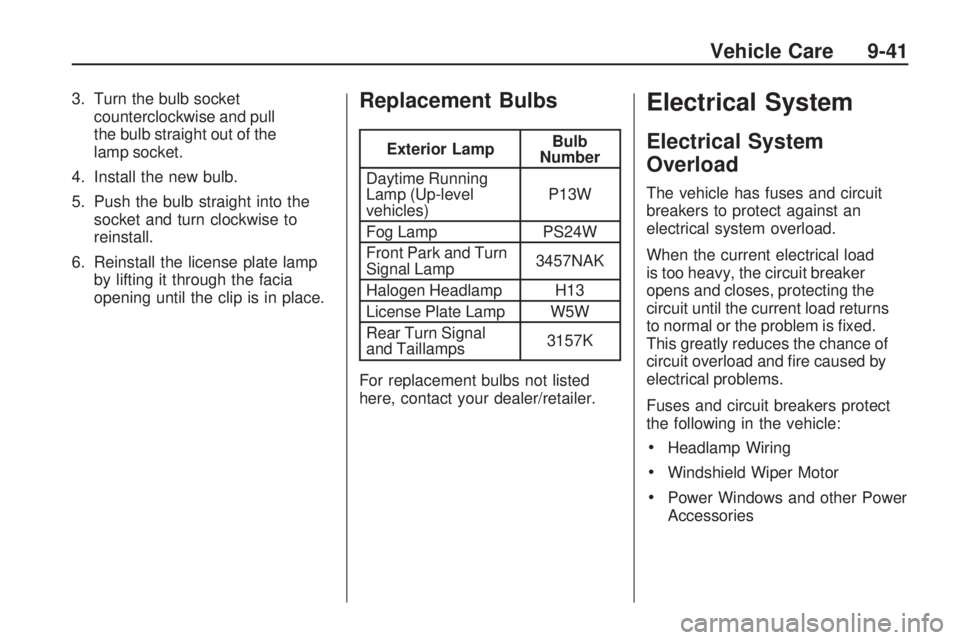
3. Turn the bulb socket
counterclockwise and pull
the bulb straight out of the
lamp socket.
4. Install the new bulb.
5. Push the bulb straight into the
socket and turn clockwise to
reinstall.
6. Reinstall the license plate lamp
by lifting it through the facia
opening until the clip is in place.Replacement Bulbs
Exterior LampBulb
Number
Daytime Running
Lamp (Up-level
vehicles)P13W
Fog Lamp PS24W
Front Park and Turn
Signal Lamp3457NAK
Halogen Headlamp H13
License Plate Lamp W5W
Rear Turn Signal
and Taillamps3157K
For replacement bulbs not listed
here, contact your dealer/retailer.
Electrical System
Electrical System
Overload
The vehicle has fuses and circuit
breakers to protect against an
electrical system overload.
When the current electrical load
is too heavy, the circuit breaker
opens and closes, protecting the
circuit until the current load returns
to normal or the problem is fixed.
This greatly reduces the chance of
circuit overload and fire caused by
electrical problems.
Fuses and circuit breakers protect
the following in the vehicle:
•Headlamp Wiring
•Windshield Wiper Motor
•Power Windows and other Power
Accessories
Vehicle Care 9-41
Page 274 of 372

Headlamp Wiring
An electrical overload may cause
the lamps to go on and off, or in
some cases to remain off. Have
the headlamp wiring checked right
away if the lamps go on and off or
remain off.
Windshield Wipers
If the wiper motor overheats due to
heavy snow or ice, the windshield
wipers will stop until the motor cools
and will then restart.
Although the circuit is protected
from electrical overload, overload
due to heavy snow or ice, may
cause wiper linkage damage.
Always clear ice and heavy snow
from the windshield before using
the windshield wipers.
If the overload is caused by an
electrical problem and not snow
or ice, be sure to get it fixed.
Fuses and Circuit
Breakers
The wiring circuits in the vehicle
are protected from short circuits by
a combination of fuses and circuit
breakers. This greatly reduces the
chance of damage caused by
electrical problems.
To check a fuse, look at the
silver-colored band inside the fuse.
If the band is broken or melted,
replace the fuse. Be sure to replace
a bad fuse with a new one of the
identical size and rating.
Fuses of the same amperage
can be temporarily borrowed from
another fuse location, if a fuse goes
out. Replace the fuse as soon as
possible.
To identify and check fuses, circuit
breakers, and relays, seeEngine
Compartment Fuse Block on
page 9-42,Instrument Panel Fuse
Block on page 9-45, andRear
Compartment Fuse Block on
page 9-46.
Engine Compartment
Fuse Block
To remove the hinged fuse block
cover, press the clip at the front of
the cover, and swing it up.
Notice:Spilling liquid on any
electrical components on the
vehicle may damage it. Always
keep the covers on any electrical
component.
9-42 Vehicle Care
Page 275 of 372

J-CaseFuses Usage
6 Wiper
12 Starter
22 Brake
Vacuum PumpJ-Case
Fuses Usage
25 Power
Windows Rear
26 Power Windows
Front
27 Rear Defog
J-Case Fuses Usage
41 Cooling Fan High
42 Front Heater,
Ventilation and
Air Conditioning
43 Antilock Brake
System Pump
44 Cooling Fan Low
Mini Fuses Usage
1 Air Conditioning
Compressor Clutch
2 Transmission
Control Module
5 Engine Control
Module Main
7 Pre-Catalytic
Converter
Oxygen Sensor
8 Post-Catalytic
Converter
Oxygen Sensor
9 Fuel
Injectors – Even
10 Fuel Injectors – Odd
Engine Compartment Fuse Block
Vehicle Care 9-43
Page 276 of 372

Mini Fuses Usage
11 Cooling Fan Relay
14Manifold Air
Flow/Chassis
Control
15 Ignition
16 Run/Crank IP
17Sensing Diagnostic
Module/Ignition
18 Run/Crank Body
19Transmission
Control Module/
Ignition
20Engine Control
Module/Ignition
31Outside Rear
View Mirror
32Canister Vent
Solenoid
33Body Control
Module #6Mini Fuses Usage
34 Sunroof
35 Front Heated Seats
38 Washer Pump Front
40Antilock Brake
System Valves
46HID Headlamp –
Left Front
47HID Headlamp –
Right Front
50 Fog Lamps
51 Horn
52 Spare
55High Beam
Headlamp – Right
Front
56High Beam
Headlamp – Left
Front
61 Heated MirrorMini
RelaysUsage
K26 Powertrain
K50 Run / Crank
K55 Rear Defog
K612 Cooling Fan High
K614 Cooling Fan Control
Micro
RelaysUsage
K61 Starter
K69 Wiper Control
K613 Cooling Fan Low
K617Air Conditioning
Compressor Clutch
K619 Wiper Speed
K627High Intensity
Discharge
Headlamps
K632Brake
Vacuum Pump
9-44 Vehicle Care
Page 277 of 372

Instrument Panel Fuse
Block
The instrument panel fuse block is
located on the end of the instrument
panel, on the driver side of the
vehicle. To access the fuses, open
the fuse panel door by pulling out.
To reinstall the door, push the door
back into its original location.
FusesUsage
F1 Discrete Logic
Ignition Switch
F2 Diagnostic Link
Connector
F3 Airbag
F4 ClusterFuses Usage
F5 Heating Ventilation
Air Conditioning
Controller
F6 Body Control
Module
F8 Battery
F9 Spare
Instrument Panel Fuse Block
Vehicle Care 9-45
Page 278 of 372

Fuses Usage
F10 Spare
F11 Spare
F12 Spare
F13 Display
F14OnStar
®Universal
Hands Free Phone
F15Body Control
Module 3
F16Body Control
Module 4
F17 Power Outlet 1
F18 Power Outlet 2
F19Steering Wheel
Controls Backlight
F20 Spare
F21 Spare
F22 Spare
F23 Trunk
F24Automatic Occupant
Sensing
Fuses Usage
F25Body Control
Module 1
F27Body Control
Module 8
F28 Spare
F29Body Control
Module 5
F30Body Control
Module 7
Circuit
BreakersUsage
CB7 Passenger Seat
CB26 Driver Seat
Relays Usage
K10Retained Accessory
Power
K605 Not Used
K609 Trunk
Rear Compartment
Fuse Block
The rear compartment fuse block is
located on the right side of the trunk
behind a cover. Remove the six
convenience net retainers, the rear
sill plate, and the two passenger side
trim retainers, then swing the trim out
of the way.
9-46 Vehicle Care
Page 279 of 372
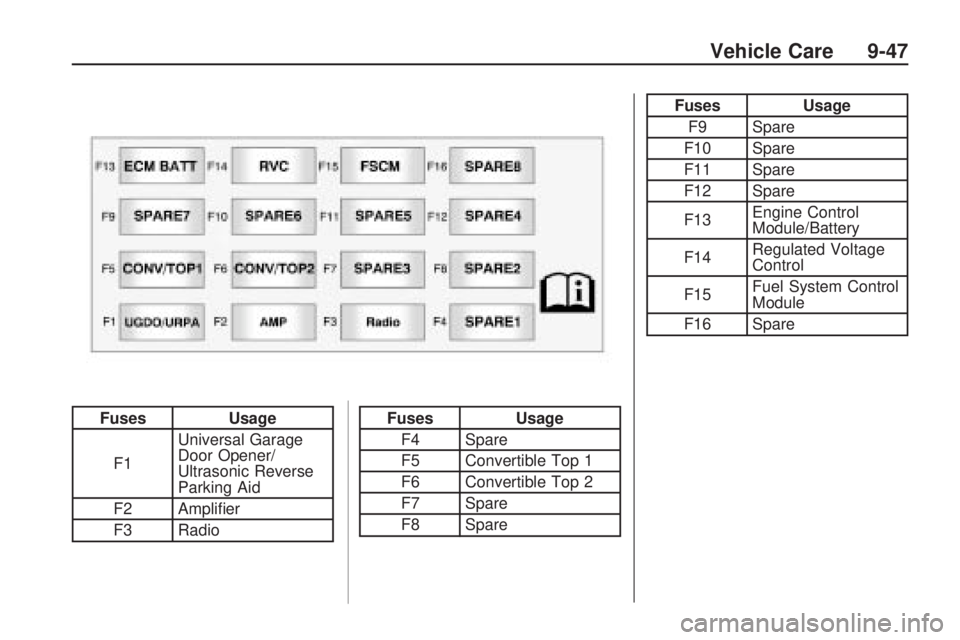
FusesUsage
F1 Universal Garage
Door Opener/
Ultrasonic Reverse
Parking Aid
F2 Amplifier
F3 RadioFuses Usage
F4 Spare
F5 Convertible Top 1
F6 Convertible Top 2
F7 Spare
F8 Spare
Fuses Usage
F9 Spare
F10 Spare
F11 Spare
F12 Spare
F13 Engine Control
Module/Battery
F14 Regulated Voltage
Control
F15 Fuel System Control
Module
F16 Spare
Vehicle Care 9-47
Page 280 of 372
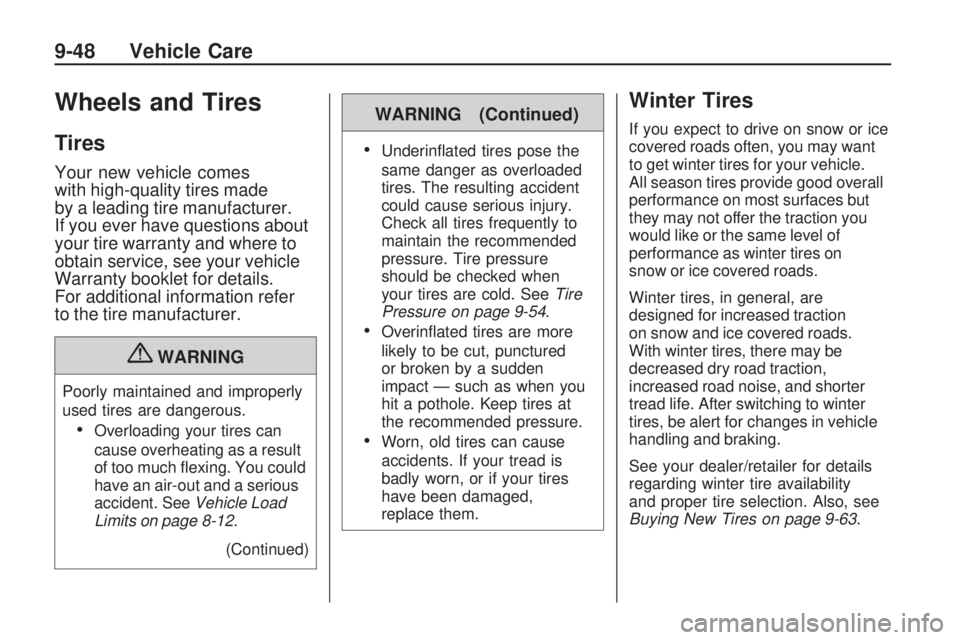
Wheels and Tires
Tires
Your new vehicle comes
with high-quality tires made
by a leading tire manufacturer.
If you ever have questions about
your tire warranty and where to
obtain service, see your vehicle
Warranty booklet for details.
For additional information refer
to the tire manufacturer.
{WARNING
Poorly maintained and improperly
used tires are dangerous.
•Overloading your tires can
cause overheating as a result
of too much flexing. You could
have an air-out and a serious
accident. SeeVehicle Load
Limits on page 8-12.
(Continued)
WARNING (Continued)
•Underinflated tires pose the
same danger as overloaded
tires. The resulting accident
could cause serious injury.
Check all tires frequently to
maintain the recommended
pressure. Tire pressure
should be checked when
your tires are cold. SeeTire
Pressure on page 9-54.
•Overinflated tires are more
likely to be cut, punctured
or broken by a sudden
impact — such as when you
hit a pothole. Keep tires at
the recommended pressure.
•Worn, old tires can cause
accidents. If your tread is
badly worn, or if your tires
have been damaged,
replace them.
Winter Tires
If you expect to drive on snow or ice
covered roads often, you may want
to get winter tires for your vehicle.
All season tires provide good overall
performance on most surfaces but
they may not offer the traction you
would like or the same level of
performance as winter tires on
snow or ice covered roads.
Winter tires, in general, are
designed for increased traction
on snow and ice covered roads.
With winter tires, there may be
decreased dry road traction,
increased road noise, and shorter
tread life. After switching to winter
tires, be alert for changes in vehicle
handling and braking.
See your dealer/retailer for details
regarding winter tire availability
and proper tire selection. Also, see
Buying New Tires on page 9-63.
9-48 Vehicle Care